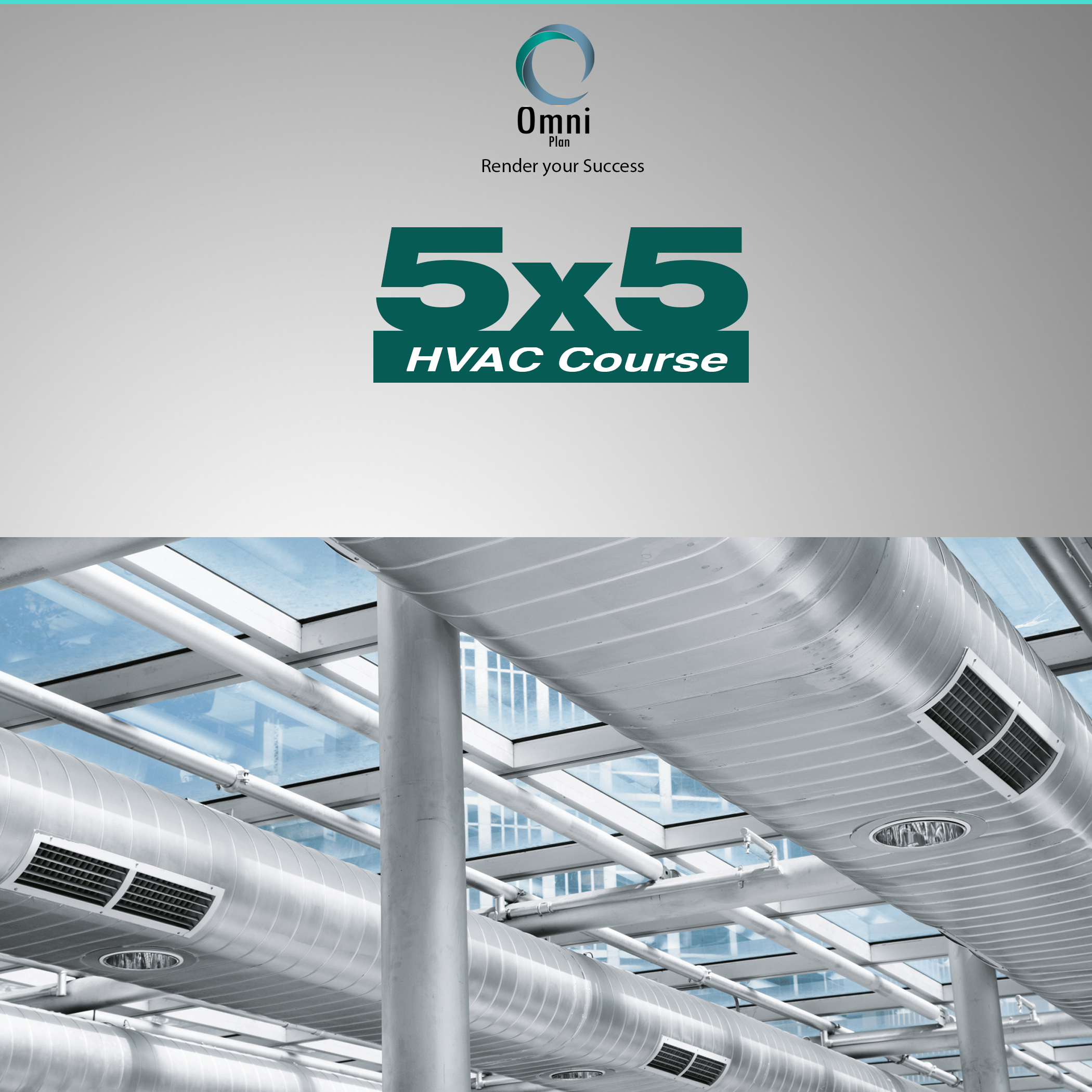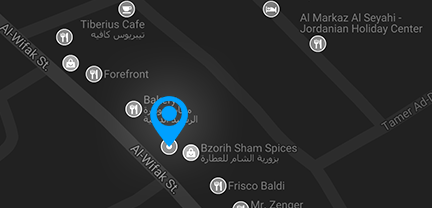Comprehensive HVAC 5X5
Course Information
Overview
In this course participants take all basic concepts and systems in heating, ventilation and air conditioning, which includes four essential subjects:
يأخذ المشاركون في هذه الدورة جميع المفاهيم والنظم الأساسية في التدفئة والتهوية وتكييف الهواء ، والتي تشمل أربعة مواد أساسية:
Full understanding of air behavior and its characteristics, effect of changing external conditions, and changing its properties.
فهم كامل لسلوك الهواء ومواصفاته, تأثير الظروف الخارجية وتأثير تتغير خصائص الهواء.
Heating and cooling systems principles and how do work
مبادئ أنظمة التدفئة والتبريد وكيف تعمل
The considerations in design process, and how to use HAP software in that
الاعتبارات في عملية التصميم ، وكيفية استخدام برنامج HAP في ذلك
Ability to size ducts by using all methods.
القدرة على تحديد أبعاد مجاري الهواء باستعمال جميع الطرق
Perform full calculations for fan, and take into consideration the factors effect on these calculations.
إنجاز حسابات كاملة للمروحة, وأخذ بعين الاعتبار العوامل المؤثرة في هذه الحسابات
Distribute inlet and outlet air terminals.
توزيع مداخل ومخارج الهواء
The methods that achieve comfort by controlling in space air diffusion.
الطرق التي يتم من خلالها تحقيق مستوى الراحة من خلال التحكم بكيفية انتشار الهواء داخل الحيزات
Air systems that used in conditioning controls
أنظمة الهواء المستخدمة في ضوابط التكييف
تشتمل هذه الدورة على تصميم خمسة أنظمة بشكل كامل على مبنى جامعي, بدءًا بالحسابات وإنشاء التقاير حتى إعداد الرسومات التصميمية وجداول الكميات BOQ, وهذه الأنظمة هي:
1) Chilled Water AHU System
2) Chilled Water FCUs System
3) CAV Reheat Terminals System
4) Package Unit
5) FAHU with Split Units
وسيتم ذلك باستعمال خمس برمجيات وهي:
1) HAP لحساب الأحمال الحرارية وتدفقات الهواء والماء
2) Duct Sizer لحساب أبعاد مجاري الهواء
3) ASHRAE Duct Fittings Data Base لحسابات المراوح
4) Pipe Flow Wizard لحسابات أقطار المواسير وحسابات المضخة
5) AutoCAD MEP وهو نسخة مطورة من AutoCAD لإعداد المخططات التصميمية
وتشتعمل الدورة على شرح تفصيلي لجميع النواحي الهندسية من ميكانيكا الموائع والديناميكا الحرارية وانتقال الحرارة, بالإضافة إلى المعايير والكودات اللازمة لتصميم أنظمة التكييف من ASHRAE, SMACNA, AMCA
Objectives
HVAC field in general is more difficult than other mechanical fields such as Fire Fighting or Plumbing, that because:
- The main aim of HVAC is achieve comfort for people, or meet the needs of some particular applications, and this depends one a lot of conditions and factors
- Deal with several materials and phases. Where there are water, air, and a lot of types of refrigerant
- In other fields usually dealing is been with incompressible fluids, but in HVAC there is an air and it is compressible, so here more difficult occurs
- Wide range of options are available for each case, unlike other fields such that there are constant requirements have not to be changed
- Standards and references that used in this field are a lot comparison with Fire Fighting or Plumbing systems
This course is design course, so participant needs to know and understand a lot of fluid characteristics, whom this course is included
مجال التكييف والتبريد بشكل عام أكثر صعوبة من باقي المجالات الميكانيكية مثل مكافحة الحريق والسمكرة, وذلك بسبب :
- الهدف الرئيس من أنظمة التكييف والتبريد هو تحقيق الراحة للناس, أو تلبية احتياجات تطبيقات معينة, وهذا يعتمد على الكثير من الظروف والعوامل
- التعمال مع عدة مواد وأطوار, حيث هنالك مياه, هواء, والعديد من أنواع مواد التبريد
- في المجالات الأخرى يتم التعمال مع موائع غير قابلة للانضغاط, لكن في أنظمة التكييف والتبريد هنالك هواء, وهو قابل للانضغاط, مما يؤدي إلى مزيد من الصعوبة
- لدينا مجال واسع من الخيارات والبدائل لكل حالة, على عكس باقي المجالات حيث تكون هنالك متطلبات ثابتة لا يمكن تغييرها
- المعايير والمراجع المستخدمة في هذا المجال كثيرة ومتعددة مقارنة بأنظمة إطفاء الحريق والسمكرة
هذه الدورة هي دورة تصميمية, لذلك فالمشارك يحتاج أن يعرف ويفهم الكثير من خصائص الموائع, والتي تم تضمينها في هذه الدورة
Audience
مهندسو الميكانيك والعاملون في مجال الاستشارات الهندسية
مهندسو الميكانيك والعاملون في مجال المقاولات والإشراف
طلاب الهندسة الميكانيكية
Outline
- Module 1: Psychrometric Chart (1.5 Hours)
- Dry bulb temperature
- Wet bulb temperature
- Dew point
- Specific humidity
- Saturation humidity
- Relative humidity
- Dew point
- Sensible heat factor
- Module 2: Psychrometric processes (1.5 hours)
- Sensible heating
- Sensible cooling
- Humidification
- Dehumidification
- Heating & humidification
- Cooling & humidification
- Heating & dehumidification
- Cooling & dehumidification
- Adiabatic mixing
- Non-adiabatic mixing
- Module 3: Air-Conditioning Systems
- Basic Air-Conditioning System
- Economizer
- Zoned Air-Conditioning Systems
- Single-Duct, Zoned Reheat, Constant-Volume Systems
- Single-Duct, Variable-Air-Volume Systems
- By-pass Box Systems
- Constant Volume Dual-Duct, All-Air Systems
- Multizone Systems
- Three-Deck Multizone Systems
- Dual-Duct, Variable-Air-Volume Systems
- Dual Path outside Air Systems
- System Choice Matrix
- Module 4: Bernoulli Equation
- Static Pressure
- Velocity Pressure
- Elevation Pressure
- Differences between these types of pressure
- Relations between energy and each type of pressure
- Module 5: Refrigeration & heat pump cycle and its components
- Compressor
- Condenser
- Expansion valve
- Evaporator
- Coefficient of Performance (COP)
- Module 6: Heating and Cooling Equipment
- DX systems (split, package, VRF)
- Hydronic systems (chillers and Boilers)
- Pipe sizing for chiller systems
- Module 7: Duct Sizing Methods
- Equal Friction
- Constant Velocity
- Velocity Reduction
- Static Regain
- Total Pressure
- Solve problems by these methods
- Module: 8: Pressure Losses
- Pressure loss chart & Ductsize software (McQuay)
- Roughness Factor
- Losses in Flexible Duct
- Flexible Duct installation and considerations
- Dynamic loss in fittings & components
- Equivalent Length Method
- Local Loss Coefficient Method
- Duct fittings codes
- ASHRAE Duct Fittings Database software program
- Module 9: Fan Calculations
- Considerations of fan pressure calculation
- Total pressure in loss series path
- Total pressure in loss parallel path
- Fan total pressure and fan static pressure
- Supply fan & exhaust fan
- Solve problems
- Module 10: Fan/System Curves
- Fan performance curves
- Fan pressure performance curve for single fan speed
- Fan pressure performance curve for multi fan speed
- Fan Laws
- Catalog Performance Tables
- The system curve
- System Constant
- Fan/System Curve and System Design Point
- Effect of changes in fan speed
- Effect of density on system resistance
- Effects of errors in estimating required pressure
- Module 11: System Effect Factor (SEF)
- AMCA installation types
- System Effect Curves
- Outlet System Effect Factors
- * Outlet ducts
- * Outlet duct elbows
- * Volume control dampers
- * Duct branches
- Inlet System Effect Factors
- * Inlet ducts
- * Inlet duct elbows
- * Inlet vortex (spin or swirl)
- * Inlet turning vanes
- * Airflow straighteners
- * Enclosures (plenum and cabinet effects)
- * Obstructed inlets
- Module 12: Air Terminal Distribution
- Diffuser, grill, and register
- Air throw
- Supply distribution
- Exhaust distribution
- Noise criteria (NC)
- Short circuit
- Module 13: Quantities Survey of Ducts
- Tour in SMACNA standard
- Determine gauge
- Quantities survey of fittings
- Module 14: Ventilation
- ASHRAE 62.1
- ASHRAE 62.2
- Module 15: HAP Software Program
- Module 16: Elite Ductsize
Testimonials



